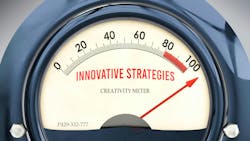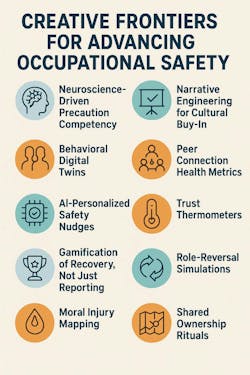Beyond the Horizon: Creative Frontiers for Advancing Occupational Safety
With workplace fatalities rising in several sectors and engagement declining, it is clear that conventional approaches to safety have reached their limits. Innovative companies and EHS professionals recognize that maintaining the status quo is not enough. Continuing the same practices will not bring about change; the systems within your organization are responsible for the results you see today. To achieve transformation, a shift in thinking and approaches is essential. As Marshall Goldsmith advises, “What Got You Here Won’t Get You There.”
To truly prevent harm and strengthen culture, safety leaders and senior executives must start asking a new type of question: What are the creative, underexplored ways to enhance occupational safety that we haven’t even begun discussing yet?
Here are ten innovative strategies—some influenced by related fields such as neuroscience, AI, organizational psychology and narrative design—that offer fresh, underutilized approaches to improving safety, culture and performance throughout an organization.
1. Neuroscience-Driven Precaution Competency
We train people to follow rules, but what if we could condition the brain itself to recognize and respond to early cues of danger—before rationalization kicks in? Emerging neuroscience technologies (like EEG feedback loops) could be used to build intuitive, near-instinctual reactions to risk precursors. This goes beyond training—it’s about rewiring perception for real-time decision quality.
2. Narrative Engineering for Cultural Buy-in
People rarely commit to rules, but they do commit to stories that resonate. Instead of preaching safety, organizations could create internal “mythologies” or choose from real employee experiences surrounding shared identity, pride and protective legacy. Think of it as culture-specific storytelling that integrates safe behaviors into a collective narrative—woven into identity rather than compliance.
3. Behavioral Digital Twins
We use digital twins for machines. Why not apply them to culture? By integrating data from observations, wearables, sentiment tools and near-miss reports, companies could simulate the potential behavioral consequences of leadership decisions in a virtual cultural environment. This enables leaders to test interventions before implementing them in the real world.
4. Peer Connection Health Metrics
Many safety programs focus on supervision, but peer relationships often have a greater impact—and are frequently overlooked. What if we could assess the health of those peer connections? By using micro-indicators (e.g., digital badges, quick sentiment polls, conversational heat maps), organizations could identify weak ties before they result in isolation, silence, or the normalization of risk.
5. AI-personalized Safety Nudges
Not all workers respond to safety messages in the same way. With AI's assistance, we can move beyond generic reminders and customize safety nudges based on individual risk profiles, work history and even emotional states. A fatigued, high-risk worker might receive a different kind of real-time intervention than a meticulous, cautious colleague.
6. Trust Thermometers
What if each work crew had real-time access to trust levels and safety confidence? By utilizing simple daily input tools (e.g., emoji sliders, 10-second trust scores, anonymous mood indicators), leaders could identify crews at risk of disengagement, breakdowns, or silence, enabling immediate support instead of reactive interventions.
7. Gamification of Recovery, not just Reporting
Most organizations encourage near-miss reporting but miss a major opportunity: celebrating creative recoveries and learning moments. Teams could earn recognition for how they respond and adapt—not just for identifying issues. This fosters a proactive, resilient mindset where everyone sees themselves as part of the solution.
8. Role-reversal Simulations
Traditional safety drills simulate response. But what if you flipped the script? In a role-reversal exercise, frontline employees could act as executives, family members or media reps following a fatal incident. This deepens empathy, reveals blind spots and enhances accountability by letting people feel the human and organizational consequences of safety breakdowns.
9. Moral Injury Mapping
While physical injuries are tracked and analyzed, moral injuries—when workers feel betrayed, coerced or silenced—are rarely acknowledged. Over time, these erode trust, increase turnover and degrade safety culture. Mapping patterns of moral harm can help leadership identify and repair cultural fractures before they metastasize.
10. Shared Ownership Rituals
Safety culture often suffers when it’s invisible or treated as a checklist. Instead, develop repeatable rituals that reinforce commitment and shared ownership—like “safety confessionals,” rotating safety stewards, or intentional huddles focused on purpose and pride. These rituals become cultural anchor points that make safety personal, visible and valued.
The Call to Action: Think Boldly. Lead Differently.
As we look to the future, the most successful organizations won’t be those with the best rules, but those with the best relationships, instincts and preparedness for what can’t be fully predicted. Occupational safety is not merely a compliance function; it’s a strategic, culture-shaping endeavor that directly affects reputation, innovation and resilience. The challenge now is to invest in creativity before crisis demands it, and to lead with creativity before incidents necessitate reinvention.
Senior leaders and safety professionals must broaden their perspective. The next frontier isn’t just safer systems—it’s smarter, more connected humans. Relationships have always been important to humans; now it’s time to embrace technological relationships to lead us to the next frontiers of safety excellence.
About the Author
Shawn M. Galloway
CEO
Shawn M. Galloway is CEO of ProAct Safety, author of several books, including Shared Ownership: Engaging the Subcultures, and host of the podcast “Safety Culture Excellence.” As an award-winning consultant, adviser, leadership coach, and keynote speaker (including at EHS Today's Safety Leadership Conference), he has helped hundreds of organizations within every primary industry to improve safety strategy, culture, leadership, and engagement. For more information, call (936) 273-8700 or email [email protected].


